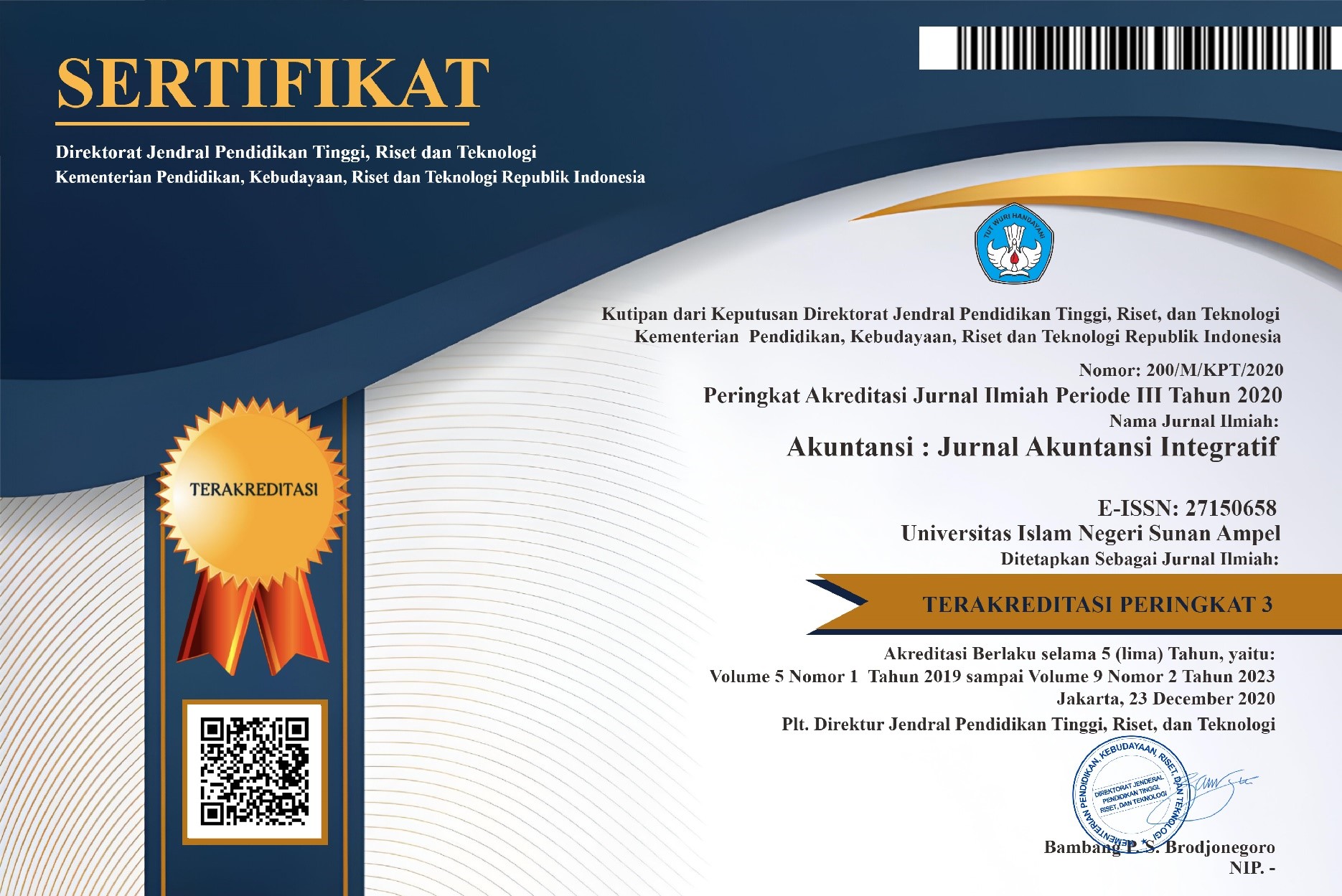AUTHOR GUIDELINES
Author Guidelines
-
JAI accepts journal articles in the following fields of study:
-
- Financial Accounting
- Management accounting
- Public sector accounting
- Islamic accounting
- Behavioral accounting
- Capital market and investment
- Auditing
- Taxation
- Accounting Education
- Accounting and Management Information Systems
- Accounting Research with a Non-Positive Paradigm Approach
-
- Articles published by JAI are articles that have never been published or are in the process of being reviewed in other journals or have been presented more than once at a conference.
- Articles are written using standard English.
- The order of writing the article consists of the Title; Writer's name; Abstract; Keywords; Introduction; Research Methods; Results and Discussion; Conclusions and References.
-
- Title: The title uses English or Indonesian for a maximum of 15 words. The title is written in accordance with the rules of Writing Title (all using capital letters) typed flat and thick.
- The author's name must be written in full without a title, the institution of origin of the author, and the complete correspondence address. If there is more than one author then one of the authors becomes the corresponding author
- Abstract and keywords are written in English and Indonesian language. Each abstract contains 150 words and is written in one paragraph, typed using italic times new roman. The abstract contains the Introduction/Main Objective, Background Problem, Novelty, Research Methods, Findings/Results, and Conclusion
- Keywords consist of 3-5 keywords
- The introduction must contain the problem, objectives, methods that will be used to answer the problem formulation, and research objectives. In addition, the introduction should also briefly appear in the literature review which is used as a basis for research. The maximum preliminary proportion is 20% of the total article length.
- The research method includes a research design that contains an explanation of the population, samples, research subjects, data collection techniques, data analysis techniques that are done.
- The results of the study and discussion contain data analysis used to answer research questions. The use of tables or graphs in the research results section is written by including the title and number of the table or graph. In addition, the author must also include sources of tables and graphs.
- The conclusions presented in the article must contain conclusions from the results of the study, the implications and suggestions for future research
- The writing of a bibliography using the APA style. Examples of the writing of bibliography from a journal are as follows:
- Sitorus, J. H. E. 2015. Membawa Pancasila dalam Suatu Definisi Akuntansi. Jurnal Akuntansi Multiparadigma, 6(2), 254-271.
- Watts, R. L., & Zimmerman, J. L. (1990). Positive Accounting Theory: A Ten Year Perspective. Accounting review, 131-156.
- If the reference comes from a book, then the writing is according to APA style as follows:
- Perekayasaan Pelaporan Keuangan. Yogyakarta: BPFE.
- Scott, W. R., and O'Brien, P. C. 2003. Financial accounting theory. Toronto: Prentice-Hall.
- If the reference comes from a seminar or workshop presented as follows:
- Anggraini, F. R. R.2006. Pengungkapan Informasi Sosial dan Faktor-Faktor yang Mempengaruhi Pengungkapan Informasi Sosial dalam Laporan Keuangan Tahunan (Studi Empiris pada Perusahaan-Perusahaan yang Terdaftar di Bursa Efek Jakarta). Simposium Nasional Akuntansi, 9, 23-26.
- Sukoharsono, E. G., and Lutfillah, N. Q. 2008. Accounting in the Golden Age of Singosari Kingdom: A Foucauldian Perspective. Simposium Nasional Akuntansi, 11, 1-21.
- If the reference comes from an institutional author (institutional author) then the writing is as follows:
- Ikatan Akuntan Indonesia. 2009. Pernyataan Standar Akuntansi Keuangan. Jakarta: Salemba Empat
- If the reference comes from a dissertation or thesis or working paper then the writing is as follows:
- Chambers, D. 2005. Earnings Persistence and the Accrual Anomaly. University of Kentucky. Working paper.
- Utama, S. 1996. The Association between Institutional Ownership and Trading Volume Reaction to Annual Earnings Announcements. Ph.D. Dissertation, Texas A&M University.
- If the reference comes from the website, the writing is as follows:
- Australian Bureau of Statistics. 2000. 1996 Queensland Census of Population and Housing: Northern (Statistical Division). Downloaded on 19 August 2001, http://www.abs.gov.au.
- Bond, T. 2004. ED1401: Childhood and Adolescence, week 12 notes. Downloaded on February 25, 2005, http://learnjcu2004.jcu.edu.au.
-
- Every article received by the JAI team will go through a review process by two reviewers using the blind review method in accordance with their respective fields of expertise.
- If there are errors in spelling or writing that are not appropriate, the JAI team will make corrections by not changing the substance of the article
- Articles must be submitted online on the page http://jurnalfebi.uinsby.ac.id/index.php/JAI
- Articles must be typed using MS Word, using 1 space, 12 font sizes, times new roman, with a maximum page length of 15-20 pages.
- Every writing reference on articles must use a reference application (Mendeley, endnote, etc.)
- The author can download the journal template at the link below : https://docs.google.com/document/d/1_0jh9fhWtTuAWwKZwHbidvt4UNHRIaD3/edit?usp=sharing&ouid=113784237464150933022&rtpof=true&sd=true








